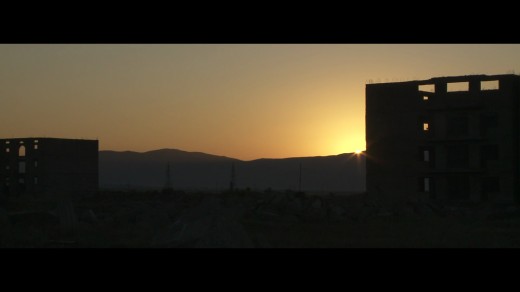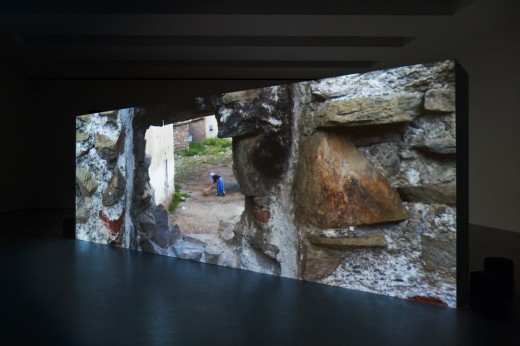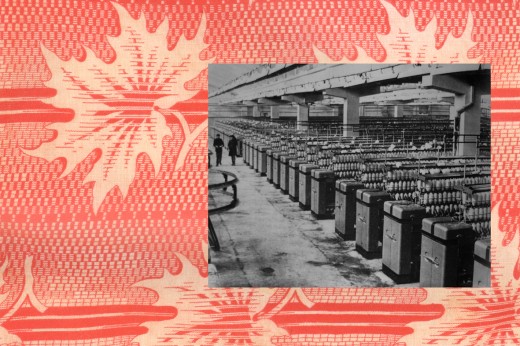The project encompasses the films Remnants of the Future, 2010, Plans for the Past, 2012 and images based works such as Dream of the Future (Mayakovsky), 2012, États des Lieux, 2012 and Still Aftershock, 2010.
“Uriel Orlow’s multi-work installation Remnants of the Future, all works 2010, ruminates on time travel, architecture and Armenia since the 1915 Ottoman-Turkish genocide, the 1988 Spitak earthquake and the collapse of the Soviet Union in 1991. The dominant element – a video loop – is a study of Mush, a vast housing project in Gyumri, northern Armenia. Mush has had two incarnations. The first Mush was the site of massacres during the 1915 genocide, the second was constructed to accommodate the people displaced by the Spitak earthquake. This project was curtailed by the break-up of the Soviet Union, leaving the reconstruction of Mush in stasis – a hollow concrete exoskeleton haunted by the spectres of failed state capitalism and the neglect of free markets.
Orlow’s Remnants of the Future is at heart a strange and subtle paean to absence, survival and the resourcefulness of people in the aftermath of a cataclysm. It is refreshing in its empathy, subtlety and resistance to mawkishness.”
Richard Thomas

Uriel Orlow, Remnants of the Future, 2010

Uriel Orlow, Remnants of the Future, 2010
HD video with stereo sound, composition by Mikhail Karikis
20m 30
Installation view at Uriel Orlow: Back to Back, Spike Island, Bristol, 2013
The film, Remnants of the Future, combines elements of documentary and sci-fi to portray precarious human existence in a post-Soviet ghost-town, an inverted ruin of the modern that is still waiting to fulfil its utopian ambition of communal living.
Remnants of the Future is set in Northern Armenia in a vast, unfinished housing project called Mush, named after the once flourishing Armenian town in Eastern Turkey, built on the orders of Mikhail Gorbachev to house the people displaced by the 1988 Spitak earthquake. The collapse of the Soviet Union in 1991 abruptly halted the ambitious housing development and it has since remained in a ghostly state of incompletion and near desertion, inhabited only by migrating birds and isolated human scavengers who salvage scrap metal out of the hollow shells of concrete and live in parts of the big, skeletal housing blocks. As the day turns into night, the soundscape, composed by Mikhail Karikis, moves from the sounds of animals and everyday activities of the few inhabitants to modulations of radiowaves emitted by pulsars, or dying stars, which still reach us after the star has died. Out of this electro-acoustic cloud a woman’s voice announces: “I am an emissary from the future….”. The time traveling character from Mayakovski’s “The Bathhouse (1930)” invites those left behind by failed state capitalism and the neglect of free markets to join her in the commune of the future.

Uriel Orlow, Plans for the Past, 2012
HD video with sound
18m 15
Installation view, CentrePasquArt, Biel, 2012 (Photo- David Gagnebin)
The second part to the Remnants of the Future project, is this film set in the original Mush in Eastern Anatolia, that provided the name for its Armenian counterpart. Once a flourishing town in Eastern Anatolia (now modern day Turkey), it became the site of massacres and deportations during the Armenian genocide of 1915. Traces of previous attempts to erase an entire people are still visible in the scarring on domestic and religious buildings.
Plans for the Past explores how this place is palimpsestically imbued with former life, historical spirits, and topographical particularities; how it is personed. The task of the spectre is to remind us that the past is an unfinished business. The logic of haunting thus disrupts the idea of chronological time, it de-synchronises time and unsettles space.

Uriel Orlow, Plans for the Past, 2012
HD video with sound
18m 15
Installation view, Spike Island, Bristol, 2013 (Photo- Stuart Whipps)

Uriel Orlow, Remnants of the Future, 2010

Uriel Orlow, Remnants of the Future, 2010

Uriel Orlow, Still Aftershock 9, 2011
Archival pigment print on Hahnemuhle paper
Edition of 5
26.8 x 40.2 cm

Uriel Orlow, Still Aftershock 5, 2011
Archival pigment print on Hahnemuhle paper
Edition of 5
26.8 x 40.2 cm

Uriel Orlow, Remnants of the Future, 2010
Installation view, CentrePasquArt, Biel, 2012 (Photo- David Gagnebin)

Uriel Orlow, Dream of the Future (Mayakovsky), 2012
Photogravure
48 x 35.7 cm